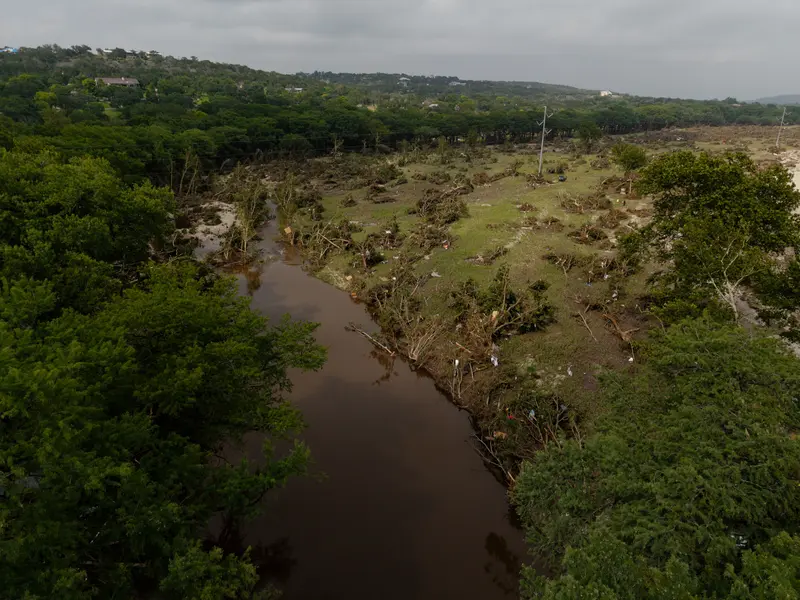Sixteen months had passed since Hurricane Harvey tore through the Texas coast in August 2017, killing more than 80 people and flattening entire neighborhoods. And when Texas lawmakers gathered in Austin for their biennial session, the scale of the storm’s destruction was hard to ignore.
Legislators responded by greenlighting a yearslong statewide initiative to evaluate flood risks and improve preparedness for increasingly frequent and deadly storms. “If we get our planning right on the front end and prevent more damage on the front end, then we have less on the back end,” Charles Perry, a Republican senator from Lubbock who chairs a committee overseeing environmental issues, said at the time.
In the years that followed, hundreds of local officials and volunteers canvassed communities across Texas, mapping out vulnerabilities. The result of their work came in 2024 with the release of Texas’ first-ever state flood plan.
Their findings identified nearly $55 billion in proposed projects and outlined 15 key recommendations, including nine suggestions for legislation. Several were aimed at aiding rural communities like Kerr County, where flash flooding over the Fourth of July weekend killed more than 100 people. Three are still missing.
But this year, lawmakers largely ignored those recommendations.
Instead, the legislative session that ended June 2 was dominated by high-profile battles over school vouchers and lawmakers’ decision to spend $51 billion to maintain and provide new property tax cuts, an amount nearly equal to the funding identified by the Texas Water Development Board, a state agency that has historically overseen water supply and conservation efforts.
Although it had been only seven years since Hurricane Harvey, legislators now prioritized the state’s water and drought crisis over flooding needs.
Legislators allocated more than $1.6 billion in new revenue for water infrastructure projects, only some of which would go toward flood mitigation. They also passed a bill that will ask voters in November to decide whether to approve $1 billion annually over the next two decades that would prioritize water and wastewater over flood mitigation projects. At that pace, water experts said that it could take decades before existing mitigation needs are addressed — even without further floods.
Even if they had been approved by lawmakers this year, many of the plan’s recommendations would not have been implemented before the July 4 disaster. But a ProPublica and Texas Tribune analysis of legislative proposals, along with interviews with lawmakers and flood experts, found that the Legislature has repeatedly failed to enact key measures that would help communities prepare for frequent flooding.
Such inaction often hits rural and economically disadvantaged communities hardest because they lack the tax base to fund major flood prevention projects and often cannot afford to produce the data they need to qualify for state and federal grants, environmental experts and lawmakers said.
Over the years, legislators have declined to pass at least three bills that would create siren or alert systems, tools experts say can be especially helpful in rural communities that lack reliable internet and cell service. A 2019 state-commissioned report estimated flood prevention needs at over $30 billion. Since then, lawmakers have allocated just $1.4 billion. And they ignored the key recommendations from the state’s 2024 flood plan that are meant to help rural areas like Kerr County, which is dubbed “Flash Flood Alley” due to its geography.

Credit:
Ronaldo Bolaños/The Texas Tribune
Spokespeople for Gov. Greg Abbott and House Speaker Dustin Burrows, R-Lubbock, did not answer questions about why the plan’s recommendations were overlooked but defended the Legislature’s investment in flood mitigation as significant. They pointed to millions more spent on other prevention efforts, including flood control dam construction and maintenance, regional flood projects, and increased floodplain disclosures and drainage requirements for border counties. Lt. Gov. Dan Patrick did not respond to questions.
This week, the Legislature will convene for a special session that Abbott called to address a range of priorities, including flood warning systems, natural disaster preparation and relief funding. Patrick promised that the state would purchase warning sirens for counties in flash flood zones. Similar efforts, however, have previously been rejected by the Legislature. Alongside Burrows, Patrick also announced the formation of committees on disaster preparedness and flooding and called the move “just the beginning of the Legislature looking at every aspect of this tragic event.” Burrows said the House is “ready to better fortify our state against future disasters.”
But Rep. Ana-María Rodríguez Ramos, a Democrat from Richardson, near Dallas, said state lawmakers have brushed off dire flood prevention needs for decades.
“The manual was there, and we ignored it, and we’ve continued to ignore these recommendations,” said Rodríguez Ramos, who has served on the House Natural Resources Committee overseeing water issues for three sessions. “It’s performative to say we’re trying to do something knowing well we’re not doing enough.”
One recommendation from the 2024 flood plan would have cost the state nothing to enact. It called for granting counties the authority to levy drainage fees, including in unincorporated areas, that could fund local flood projects. Only about 150 of 1,450 Texas cities and counties have dedicated drainage fees, according to a study cited in the state assessment.
Kerr, a conservative county of 53,000 people, has struggled to gain support for projects that would raise taxes. About a week after the flooding, some residents protested when county commissioners discussed a property tax increase to help cover the costs of recovery efforts.
The inability to raise such fees is one of the biggest impediments for local governments seeking to fund flood mitigation projects, said Robert R. Puente, a Democrat and former state representative who once chaired the state committee responsible for water issues. Lawmakers’ resistance to such efforts is rooted in fiscal conservatism, said Puente, who now heads the San Antonio Water System.
“It’s mostly because of a philosophy that the leadership in Austin has right now, that under no circumstances are we going to raise taxes, and under most circumstances we’re not even going to allow local governments to have control over how they raise taxes or implement fees,” he said.
Another one of the flood plan’s recommendations called for lawmakers to allocate money for a technical assistance program to help underresourced and rural governments better manage flood prone areas, which requires implementing a slew of standards to ensure safe development in those hazardous zones. Doing this work requires local officials to collect accurate mapping that shows the risk of flooding. Passing this measure could have helped counties like Kerr with that kind of data collection, which the plan recognized is especially challenging for rural and economically disadvantaged communities.
Insufficient information impacts Texas’s ability to fully understand flood risks statewide. The water board’s plan, for example, includes roughly 600 infrastructure projects across Texas in need of completion. But its report acknowledged that antiquated or missing data meant another 3,100 assessments would be required to know whether additional projects are needed.
In the Guadalupe River region, which includes Kerr County, 65% of areas lacked adequate flood mapping. Kerrville, the county seat, was listed among the areas identified as having the “greatest known flood risks and mitigation needs.” Yet of the 19 flood needs specific to the city and county, only three were included in the state plan’s list of 600. They included requests to install backup generators in critical facilities and repair low-water crossings, which are shallow points in streets where rainwater can pool to dangerous levels.
At least 16 other priorities, including the county’s desire for an early warning flood system and potential dam or drainage system repairs, required a follow-up evaluation, according to the state plan. County officials tried to obtain grants for the early warning systems for years, to no avail.

Credit:
Brenda Bazán for The Texas Tribune
Gonzales County, an agriculture-rich area of 20,000 people along the Guadalupe River, is among the rural communities struggling to obtain funding, said emergency management director Jimmy Harless, who is also the county’s fire marshal. The county is in desperate need of a siren system and additional gauges to measure the river’s potentially dangerous flood levels, Harless said, but doesn’t have the resources, personnel or expertise to apply for the “burdensome” state grant process.
“It is extremely frustrating for me to know that there’s money there and there’s people that care, but our state agency has become so bureaucratic that it’s just not feasible for us,” Harless said. “Our folks’ lives are more important than what some bureaucrat wants us to do.”
For years, Texas leaders have focused more on cleaning up after disasters than on preparing for them, said Jim Blackburn, a professor at Rice University specializing in environmental law and flooding issues.
“It’s no secret that the Guadalupe is prone to flash flooding. That’s been known for decades,” Blackburn said. “The state has been very negligent about kind of preparing us for, frankly, the worst storms of the future that we are seeing today because of climate change, and what’s changing is that the risks are just greater today and will be even greater tomorrow, because our storms are getting worse and worse.”
At a news conference this month, Abbott said state committees would investigate “ways to address this,” though he declined to offer specifics. When pressed by a reporter about where the blame for the lack of preparedness should fall, Abbott responded that it was “the word choice of losers.”
It shouldn’t have taken the Hill Country flooding for a special session addressing emergency systems and funding needs, said Usman Mahmood, a policy analyst at Bayou City Waterkeeper, a Houston nonprofit that advocates for flood protection measures.
“The worst part pretty much already happened, which is the flooding and the loss of life,” he said. “Now it’s a reaction to that.”
Misty Harris contributed research.










